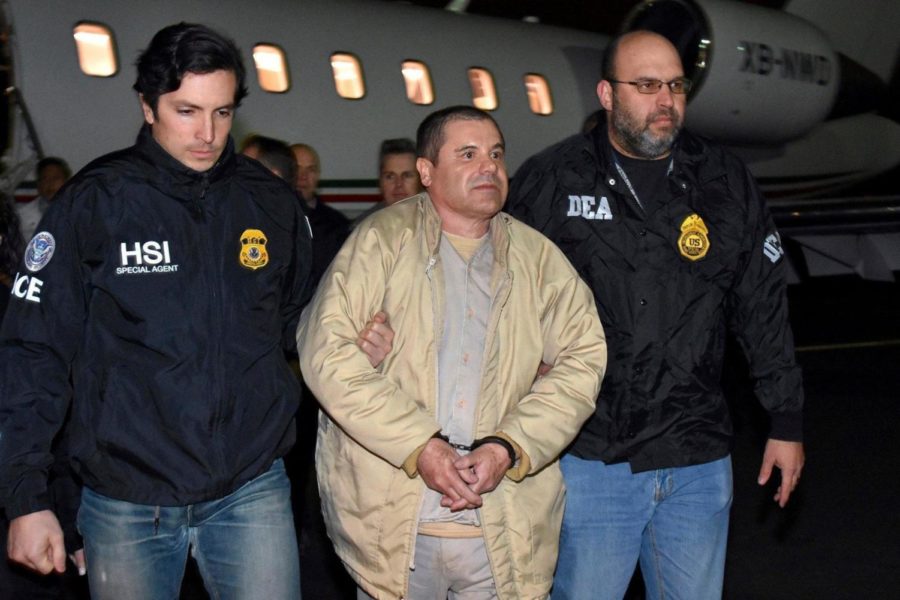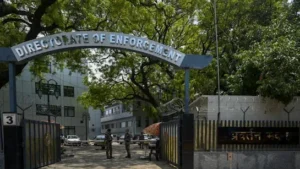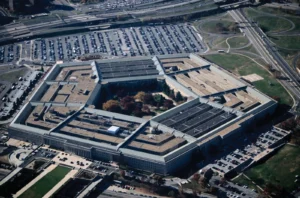The Hunt for El Chapo: The Rise and Fall of a Drug Lord
Imagine the most heavily guarded prison in Mexico. We’re talking tall mesh fences, huge watchtowers, and an area that’s a strict no-fly zone. This place is considered, well, unescapable. Yet, on a particular day, someone did escape. This someone happened to be Joaquín Archivaldo Guzmán Loera, better known as El Chapo, arguably the world’s most powerful drug lord. He didn’t use violence, nor did he climb over any fences. All he did was walk into his shower and, poof, disappear. This is the incredible story of how El Chapo rose to become one of the most successful drug dealers in history, how authorities hunted him for decades, how he escaped them time and time again, and how, in the end, an interview with a Hollywood actor and even a failing car engine ultimately brought him down.
From Poverty to Kingpin: El Chapo’s Early Life and Rise
Joaquín Archivaldo Guzmán Loera was born on April 4th, 1957, into a poor family in a humble village called La Tuna, nestled in Mexico’s Sierra Madre Mountains. Now, boys growing up in this region, they don’t typically dream of becoming astronauts or firefighters. They often aspire to be drug traffickers. It’s seen as a way to make money, and money, in their world, is a way out of poverty.
People would eventually call Guzmán “El Chapo,” a nickname meaning “Shorty,” because of his height; he never grew taller than a meter and sixty seven centimeters. El Chapo dropped out of school early, not even finishing elementary school. Instead, he spent his time working on the marijuana and poppy fields, which was, you know, a family tradition.
From a young age, El Chapo was incredibly ambitious. He made friends with some big names in the local drug scene, determined to rise through the ranks of Mexican organized crime. First, he became what they called a “problem solver.” Whenever a truckload of drug shipment missed schedule, El Chapo would, well, eliminate the person responsible. His uncompromising attitude made him trustworthy, and he grew close to the kingpin of the Guadalajara cartel. When that boss was arrested, El Chapo kept the business running, ultimately setting up his own organization with other traffickers: the infamous Sinaloa cartel. He organized planes, trucks, and rail cars to deliver cocaine and heroin into the United States. And, quite notably, he even built border crossing tunnels, a skill that would come in handy many years later.
- Origins: Born into poverty in La Tuna, Mexico (1957).
- Nickname: “El Chapo” (Shorty) due to his height.
- Early Life: Dropped out of elementary school, worked in marijuana and poppy fields.
- Ambition: Befriended local drug figures, determined to rise in organized crime.
- “Problem Solver”: Eliminated individuals responsible for delayed drug shipments.
- Sinaloa Cartel: Founded his own organization, coordinating drug delivery into the US.
- Tunnel Building: Developed expertise in constructing border crossing tunnels.
The Guadalajara Airport Shootout: A Cardinal’s Tragic Death
In those early years, one incident really put El Chapo on the map, though perhaps not in the way he would have wanted. This is “Juan Jesús Posadas Ocampo.” He was the Archbishop of Guadalajara and a cardinal, one of the highest ranks in the Catholic Church. Posadas was a popular man. He advocated for the poor and publicly condemned the drug trade.
One day, he was on his way to the airport to meet an ambassador from the Vatican. At the same time, El Chapo and his bodyguards pulled into the parking lot. They were there to catch a flight to the beach resort town of Puerto Vallarta, one of El Chapo’s favorite places to party. We don’t know exactly what happened in that parking lot next. One thing we know for sure, though: the Cardinal would not survive.
This is the official version of events: two brothers ran a drug trafficking operation out of Tijuana. They were at war with El Chapo and his cartel, fighting over drug running territory. Somehow, they got wind that El Chapo was going to be at the airport that day. So, one of the brothers and a group of gunmen rushed there to ambush him. When they spotted him and his bodyguards, they stepped out of their cars and opened fire. El Chapo and his men ran toward the terminal building, taking cover behind cars in the lot. It rained bullets, but somehow they managed to escape without getting hit. The failed assassination left seven people dead, among them, the cardinal. This was the version authorities would publicly report: Posadas was caught in the crossfire. Wrong time, wrong place.
But there were, and still are, doubts about this story. His death didn’t appear like a coincidence. Forensic experts would later say it was likely that the gunmen killed the cardinal deliberately. He was shot 14 times from close range. Later, officials suggested the gunmen had mistaken the cars. El Chapo regularly drove a white Mercury Grand Marquis, the same model Posadas sat in that day. The gunmen, they said, thought it was El Chapo’s car and opened fire. But the cardinal wore his robe when he was shot. He was not dressed at all like a drug lord. If the gunmen killed him at a close range, how could they have confused him with El Chapo? Years later, the successor of Posadas would make a serious accusation. He claimed the murder of the cardinal was a crime of the state. He believed the police carried out the killing for the Mexican government, as Posadas had accused government officials of having ties to these cartels. Up to this day, it remains a mystery what really happened in 1993 at Guadalajara airport.
- Victim: Juan Jesús Posadas Ocampo, Archbishop of Guadalajara, publicly condemned drug trade.
- Incident: Shootout at Guadalajara airport in 1993 between El Chapo’s men and rivals.
- Official Version: Cardinal caught in crossfire, mistaken identity.
- Doubts: Shot 14 times at close range, wore cardinal’s robe (not a drug lord’s attire), successor claimed it was a “crime of the state” due to government ties to cartels.
- Unresolved Mystery: What truly happened remains unclear.
First Capture and Escape: The Laundry Cart Legend
Just two months after that chaotic shootout at Guadalajara airport, the Mexican government placed a bounty on El Chapo. It took just two weeks until he was found and arrested. He denied being responsible for the death of the cardinal, insisting that he was the supposed target of the shootout. Ultimately, the authorities believed him. They didn’t charge him for homicide, just for drug trafficking. He was sentenced to 20 years in a Mexican prison.
But even behind bars, he continued to run the Sinaloa cartel. Through his lawyers, he passed orders to his closest allies. He didn’t need to be in the room to pull strings; his empire ran on whispered instructions and tightly coordinated moves. Sometimes, real power is, well, remote.
In 2001, El Chapo had enough of life in prison. Also, the Mexican Supreme Court had just approved a law that made it easier to extradite criminals like him to the US. Time to get out. The official version of his first prison escape is, frankly, spectacular. He supposedly bribed a guard who helped him climb into a laundry cart. The guard then pushed the cart out of the cell, down the hallways, and through an unguarded gate to the parking lot. El Chapo jumped out and climbed into the trunk of a car. The guard got in and drove to the outer prison gate. After a quick search, the car was waved through. Nobody checked the trunk.
But again, that’s just the official story. Several authors and journalists don’t buy it. One argues that the prison’s checkpoints were equipped with heat and motion sensors capable of detecting any living creature, even a cat. That would mean the alarms would have gone off. Instead, the journalist suggests that El Chapo may have left the prison dressed in a police uniform, escorted by other corrupt officers. One way or another, systemic corruption likely played a role, and El Chapo put his newly won freedom to use.
- First Arrest: Captured two months after Guadalajara shootout, sentenced to 20 years for drug trafficking.
- Remote Control: Continued to run Sinaloa cartel from prison via lawyers.
- First Escape (2001): Official story: bribed guard, escaped in a laundry cart.
- Skepticism: Journalists doubt the laundry cart story due to prison sensors; suggest escape in police uniform with corrupt officers.
- Systemic Corruption: Likely played a significant role in his escape.
The Rise to Global Infamy: War on Drugs and Expansion
In the years following his first escape, the Mexican cartel landscape changed dramatically. In 2002, the leader of the Tijuana cartel was killed in a shootout with police; this was one of the brothers who had supposedly tried to assassinate El Chapo at the airport. A year later, the leader of the Gulf cartel was arrested. Two major cartels were now without leadership. El Chapo saw an opportunity. He pushed into Tijuana and Gulf territory, triggering brutal fighting. Nuevo Laredo, an area along the US Mexican border, practically turned into a war zone.
Former forces of the Mexican army began working for El Chapo. They clashed with what was left of the Gulf Cartel, whose core fighters were partly trained by the US. Early on, the violence resulted in more than a thousand deaths, many of them civilians. And that was only the beginning.
In 2006, “Felipe Calderón” became Mexico’s new president, determined to crack down on organized crime. He declared war on the cartels and deployed the military. The violence escalated dramatically. Between 2007 and 2014, over 160,000 people died in the course of the war on drugs in Mexico. In these years of bloodshed, El Chapo rose. He became the world’s most wanted criminal, transforming the Sinaloa cartel into one of the most powerful criminal organizations in history. It became the top supplier of drugs to the United States: cocaine, heroin, methamphetamine, and fentanyl. El Chapo’s cartel operated in 50 countries and generated billions of dollars in profits each year. In turn, El Chapo became extremely wealthy, eventually making Forbes’ list of the world’s billionaires. No wonder it was hard to keep him locked up.
- Cartel Vacuum: Leaders of Tijuana and Gulf cartels killed/arrested, creating opportunity for El Chapo.
- Territorial Expansion: El Chapo pushed into rival territories, leading to brutal violence (e.g., Nuevo Laredo).
- “War on Drugs”: Mexican President Felipe Calderón declared war on cartels (2006), escalating violence (160,000+ deaths, 2007-2014).
- El Chapo’s Ascent: Became world’s most wanted criminal, transformed Sinaloa cartel into a global powerhouse.
- Global Reach & Wealth: Cartel operated in 50 countries, generated billions, making El Chapo a Forbes billionaire.
The Second Capture and the Infamous Tunnel Escape
El Chapo’s rescue commando needed to know the exact location of his prison cell. So, they smuggled a GPS watch into his prison cell, disguised as a food item. Now, the workers knew in what direction they needed to dig. Over the span of a year, they dug a sophisticated tunnel. A carefully planned, complex construction costing approximately five million dollars to make. The tunnel was one and a half kilometers long and one point seven meters high. It was reinforced by a wooden frame. There were lights and even a ventilation system. Digging a tunnel creates a lot of dirt, so the workers built a rail system with a motorcycle adapted to it to move the dirt out of the tunnel. The construction was also supposed to function as an escape vehicle later on.
But how did El Chapo end up in Altiplano Maximum Security Prison in the first place? “Andrew Hogan” was an agent with the Drug Enforcement Agency (DEA). He wanted to take down the most powerful drug lord on Earth, perhaps in history. But he soon discovered that, somehow, there was no task force, no team, not even a single federal agent assigned to the job of bringing El Chapo to justice. So, he took a Spanish class and prepared to move to Mexico.
Meanwhile, one of Andrew’s colleagues in the US managed to get the PIN to El Chapo’s Blackberry, thanks to someone in his inner circle. He tracked down his phone to the holiday resort of Cabo San Lucas. The colleague immediately called Andrew. They were excited, and so they passed the information to the officials in Mexico. The DEA and Mexican police quickly headed down to the place where El Chapo was supposedly hiding, but he was nowhere to be found. Next, they narrowed down El Chapo’s phone signal to one of three mansions near the resort of Cabo San Lucas. This time, it was a hit. He was there. But before the forces arrived, El Chapo just escaped through the back door. Somehow, he made it to an airstrip without being caught and was flown to safety.
El Chapo always seemed to be one step ahead. He constantly changed his SIM cards and phones and simply outsmarted the authorities. One DEA agent supposedly said the Mexicans couldn’t catch El Chapo if he was standing at the Starbucks across the street from the embassy. But Andrew Hogan didn’t give up. In May 2012, he moved to Mexico City with his family and took over the Sinaloa case. In the months that followed, he and his team began intercepting members of El Chapo’s inner circle. Bit by bit, they uncovered the cartel’s complex communication system: how often numbers were changed, possible code names, and GPS locations. Slowly, a picture began to emerge.
One day, El Chapo seemingly wanted to meet an underling in person, and he sent one of his chauffeurs to pick him up. Hogan tracked his phone. The chauffeur finally arrived at a place in Culiacán. The signal led to a group of five houses. Hogan organized a capture operation with dozens of Mexican Marines, helicopters, and trucks, and he joined the mission himself. They surrounded the property and stormed inside, but once again, El Chapo was gone. Instead, they found a strangely placed bathtub covering the entrance to a tunnel that led into the sewers of Culiacán.
But this time, the Marines managed to stay on El Chapo’s tail. Three days later, they found out that one of his men had driven him to the coastal town of Mazatlán to a hotel. The Marines entered the fourth floor of the hotel. They stormed into room 401, heading straight for the bedroom. El Chapo was with his family. He barricaded himself in the bathroom with an assault rifle. His wife pleaded with the soldiers not to harm their daughters. Shortly after, El Chapo surrendered. They got him. Andrew Hogan’s job was done. He had caught the most wanted man on the planet. He worried for the safety of his family, who had moved to Mexico with him, so they boarded a plane back to the US. Meanwhile, El Chapo went to Altiplano. The US was pushing hard for his extradition. This would likely be his doom, the end of his reign. Time for another tunnel.
The rescue team and the workers managed to locate the exact spot of El Chapo’s cell shower. They built a 10 meter vertical passageway that connected the tunnels to the cell, including a ladder. All this digging and drilling created a lot of noise. Several inmates complained, but the guards ignored them. El Chapo’s rescue team managed to complete the five million dollar tunnel directly into his prison cell without anyone interfering. All that was left was breaking through the cell floor.
And thus came the day. El Chapo sat on his bed. A surveillance camera monitored him closely. The camera also recorded audio. You could hear a television. The volume was turned up, but you also heard loud banging noises. Probably someone was breaking through the cell floor. Next, El Chapo began to pace up and down in his cell. After some time, he walked to his shower stall, bent over, and went back to his bed. He removed his shoes, sat for a second, then he walked behind the shower wall, and simply disappeared. He squeezed through the hole in the ground, just 50 by 50 centimeters wide. One meter below, he found footing on a ladder. He climbed down 10 meters into the ground until he reached the tunnel. Someone was already waiting for him, likely his wife’s brother. The rescuer sat on the motorcycle and rails. El Chapo climbed on behind him. Together, they made the one and a half kilometer ride to the other end of the tunnel. When they arrived, El Chapo and his companion climbed up a small ladder through the exit shaft. They ended up in an unfinished house covered with construction material. An ATV was parked outside. They drove a short distance to a warehouse and switched to an SUV. Then, they drove for two hours until they arrived at an airstrip. A plane was already waiting. They boarded it and flew to Sinaloa.
- Tunnel Construction: A 1.5 km, $5 million tunnel built over a year, with lights, ventilation, and a rail system with a motorcycle. GPS watch smuggled into cell for precise digging.
- DEA Hunt (Andrew Hogan): DEA agent Andrew Hogan took lead, tracked El Chapo via Blackberry PIN to Cabo San Lucas, but El Chapo escaped.
- Communication Interception: Hogan’s team intercepted El Chapo’s inner circle, uncovering cartel communication methods.
- Culiacán Escape: El Chapo escaped through a hidden tunnel under a bathtub into the city sewers during a raid.
- Second Capture (Mazatlán): Tracked to a hotel in Mazatlán, barricaded himself in a bathroom, then surrendered.
- Second Prison Escape (Altiplano): Escaped via a 10m vertical shaft from his shower into the pre built tunnel, then rode a motorcycle through the tunnel.
- Suspected Inside Job: Guards delayed checking cell, inmates complained of drilling noise; many Mexicans believed it was an inside job.
- Official Repercussions: Prison warden and officials fired, some charged for complicity.
The Sean Penn Interview and Final Capture
Two months after his second escape, one of El Chapo’s sons posted a tweet: “I’m doing fine here. You already know with whom.” Attached was a photo, presumably with his father. The tweet was tagged with a location: Costa Rica. Let’s back up for a second. Some things about this spectacular escape just don’t add up. There’s video footage of guards watching their screens as El Chapo disappeared. Yet, it took them 20 minutes to check a cell. They even waited a few more minutes before they finally entered and checked the escape hole. Also, it seems unlikely that building such a tunnel truly went unnoticed; after all, inmates actively complained about the drilling noise. A large majority of Mexicans believed the escape was an inside job. Shortly after El Chapo’s second prison escape, the prison’s warden and two other officials were fired. Next, four Mexican officials were charged. Two were members of Mexico’s Secret Service based at the prison. The other two were guards who sat in the control room monitoring El Chapo’s cell. The accusation was that they bought El Chapo valuable time by not raising the alarm once the drug lord was gone. And El Chapo, he again became one of the most wanted criminals on Earth. The pressure to finally bring him to justice was higher than ever. The hunt was on.
Then El Chapo made a crazy move. He knew he was considered a legend in Mexico, and he wanted even more fame: a movie about his life on the big screen. Sean Penn was already involved in a production about him, along with Mexican actress “Kate del Castillo.” Castillo managed to contact El Chapo and his associates. Finally, El Chapo agreed to meet her and Sean Penn in person to talk about the movie, while technically he was on the run. This is a photo of the meetup. Sean Penn interviewed El Chapo about his career as a drug lord, a story later published by Rolling Stone. In it, Penn revealed that El Chapo’s escape tunnel engineers had been flown to Germany for three months of extensive additional training, necessary to deal with the low lying water table beneath the prison. It’s a gripping read. Beneath his smile, there’s a doubtlessness to his facial expression. A question comes to mind as I observe his face, both as he speaks as while he listens: “What is it that removes all doubt from a man’s eyes? Is it power, admirable clarity, or soullessness?” But according to government sources, the interview was also a crucial factor for investigators to get closer to El Chapo. Apparently, all the while, they were monitoring Penn and Castillo’s movements very closely.
It was October 9th, 2015. Mexican special forces were closing in on him in the mountains of Sinaloa. After a while, they actually spotted him. He had only one bodyguard with him. This was their moment. They took off after them, chasing them through the terrain. As they got nearer, El Chapo fell off a cliff. His bodyguard found him and carried him to the depths of the forest. The special forces lost sight of them, and they escaped. A catastrophic failure, but the authorities didn’t give up the hunt.
In January 2016, they got another chance. The Marines managed to locate El Chapo once again in the coastal city of Los Mochis. The clue came from a taco order placed from a white van. Witnesses said the driver was one of El Chapo’s men. The Marines began to surveil the car. It ultimately led them to a safe house. A few hours later, the soldiers stormed the place. Cartel gunmen tried to hold them off. A gunfight broke out. The Marines eventually pushed up to the second floor, then the roof, but El Chapo was gone. True to his form, he and one of his gunmen fled through a hidden tunnel. Right now, they were climbing out of a drainage tunnel a short distance away, right across from a Walmart. El Chapo and his gunman needed to escape quickly. They stole a car, guns drawn, but after just driving a few blocks, the car broke down. So they ditched it and lost valuable time. Then they took over another car and managed to get on the highway, but it was too late. Police finally arrested El Chapo, one of history’s most powerful drug lords. He told the officers, “You are all going to die.” 40 of his assassins were supposedly on their way to free him, but he got handed over to the Marines, and it was over. After a decade of hide and seek, escaping over and over again, and in all likelihood protected by systemic corruption, El Chapo had finally been caught. Later that day, the Mexican president tweeted, “Mission accomplished. We have him.”
- Sean Penn Interview: El Chapo sought a movie about his life, met Sean Penn and Kate del Castillo (Mexican actress) while on the run.
- Rolling Stone Article: Penn’s interview published, revealed details like tunnel engineers’ training in Germany.
- Crucial Intel: Government sources monitored Penn and Castillo, using their movements to track El Chapo.
- Sinaloa Mountains Escape: El Chapo and bodyguard escaped Mexican special forces after a cliff fall.
- Los Mochis Raid: Located via a taco order, El Chapo fled through another hidden tunnel.
- Final Capture: Stole a car, which broke down, then stole another, but was finally arrested by police on the highway.
- Threat to Officers: Told arresting officers, “You are all going to die.”
- Systemic Corruption: His repeated escapes were likely facilitated by widespread corruption.
Life in Supermax and the Cartel’s Enduring Power
Soon after his final capture, El Chapo was extradited to the United States, the one thing he truly feared. On July 17th, 2019, three years after his second escape, he was sentenced to life in Colorado’s Supermax prison. That’s why he remains locked up to this day.
However, the story doesn’t quite end with El Chapo’s imprisonment. The Sinaloa cartel and other Mexican cartels are, it seems, as strong as ever, operating as undeterred global organizations. His capture, while a significant victory for law enforcement, didn’t dismantle the vast criminal enterprise he helped build. The flow of drugs continues, and the violence often associated with it persists. It’s a complex problem, one that goes far beyond the capture of any single individual, no matter how powerful.
- Extradition: Sent to the United States, his greatest fear.
- Sentence: Sentenced to life in Colorado Supermax prison (July 17, 2019).
- Cartel’s Persistence: Sinaloa and other Mexican cartels remain powerful, operating globally despite El Chapo’s imprisonment.
Key Takeaways and Summary
The life of Joaquín “El Chapo” Guzmán Loera is a dramatic saga of ambition, violence, and an astonishing ability to evade capture. Rising from poverty in rural Mexico, he quickly established himself as a ruthless “problem solver” before founding the powerful Sinaloa cartel. His early career was marked by the mysterious Guadalajara airport shootout, where a cardinal was killed, an event still shrouded in controversy.
El Chapo’s first prison escape in 2001, allegedly in a laundry cart, highlighted the systemic corruption that often facilitated his freedom. His subsequent rise to global infamy saw the Sinaloa cartel become a multi-billion dollar enterprise, fueled by the escalating “War on Drugs” in Mexico. His second, even more elaborate, prison escape in 2015 via a sophisticated tunnel captured worldwide attention and further exposed complicity within the Mexican prison system.
Ultimately, a combination of relentless DEA pursuit, his own desire for fame (leading to the Sean Penn interview), and a series of operational mishaps led to his final capture in 2016. Extradited to the US, he was sentenced to life in Supermax prison. Despite his imprisonment, the enduring power of Mexican cartels, including the Sinaloa cartel, underscores the complex and persistent challenges of global drug trafficking.
Key Important Points:
- Rise to Power: El Chapo’s ambitious and ruthless ascent from humble beginnings to lead the powerful Sinaloa cartel.
- Escapes: Two highly publicized prison escapes, both likely facilitated by systemic corruption, showcasing his ingenuity and the cartel’s reach.
- Global Influence: Transformed the Sinaloa cartel into a multi-billion dollar global drug trafficking organization.
- “War on Drugs” Context: His rise coincided with and contributed to intense violence during Mexico’s “War on Drugs.”
- Final Capture: A combination of sustained law enforcement efforts, his own celebrity pursuit (Sean Penn interview), and operational errors led to his final arrest.
- Imprisonment & Legacy: Sentenced to life in US Supermax prison, but Mexican cartels continue to operate powerfully.





